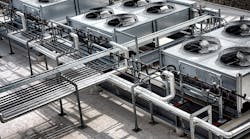The acronym HVAC doesn’t seem to have enough letters anymore, as buildings require more than just heating, air conditioning and ventilation to operate efficiently and promote productivity. While the name HVAC isn’t likely to undergo any changes, the industry itself is evolving to leverage four main objectives.
1) Comfort
Objectives for traditional HVAC equipment have remained simple since their implementation in the early 20th century, but buildings require more nuanced options. Manufacturers have identified comfort more broadly as the most important function of HVAC systems. In addition to thermal comfort, modern HVAC systems address indoor air quality (IAQ) writ large.
Facilities managers are able to optimize IAQ through best practices like air filtration, but the goal of HVAC manufacturers is to have greater oversight of environmental concerns in buildings. Integrating humidity control with your system is one area engineers are increasingly addressing because a more precise balance of temperature and humidity will reduce mold and the impact of sick building syndrome, both of which significantly impact workplace productivity and absenteeism.
Although the industry has yet to implement some of that technology into its systems, there are plenty of innovations that you can integrate into your system to improve occupant comfort and efficiency. One such area is with higher grade occupancy sensors. Traditionally, occupancy sensors have been able to simply identify whether a room is currently occupied, but new sensors take that a step further. Now they are able to identify where people are in a room and how active they are, which allows the system to adequately diffuse air to modulate temperature.
Related:
5 IAQ Myths that Jeopardize Workplace Wellness
2-3) Control & Communications
The best way to modulate optimal comfort in a building is to have significant control of your equipment, and aligning your system via a communications protocol is key to achieving that.
Of systems that provide significant control in their operation, ductless systems like variable refrigerant flow (VRF) address thermal comfort issues by providing more individualized control over spaces. The lack of ducts also makes them a viable choice for retrofits.
No matter what kind of system you are using, it is important to link them together, as that enables the most efficient HVAC practices. Communications goes hand-in-hand with controls in HVAC systems, so it is important to identify the communications protocol your equipment can connect to so you can learn where you are wasting energy and find opportunities for integration with other building systems.
Related:
Variables for Retrofitting with VRF
The Emergence of VRF as a Viable HVAC Option
4) Cost
Despite the technological changes that have occurred with HVAC, the one goal that remains the same is reducing costs. By addressing comfort, maintaining better control and implementing communications between hardware, systems are becoming more efficient. There’s no need for a trade-off with heating and cooling; it’s about leveraging technologies to achieve all four objectives.


